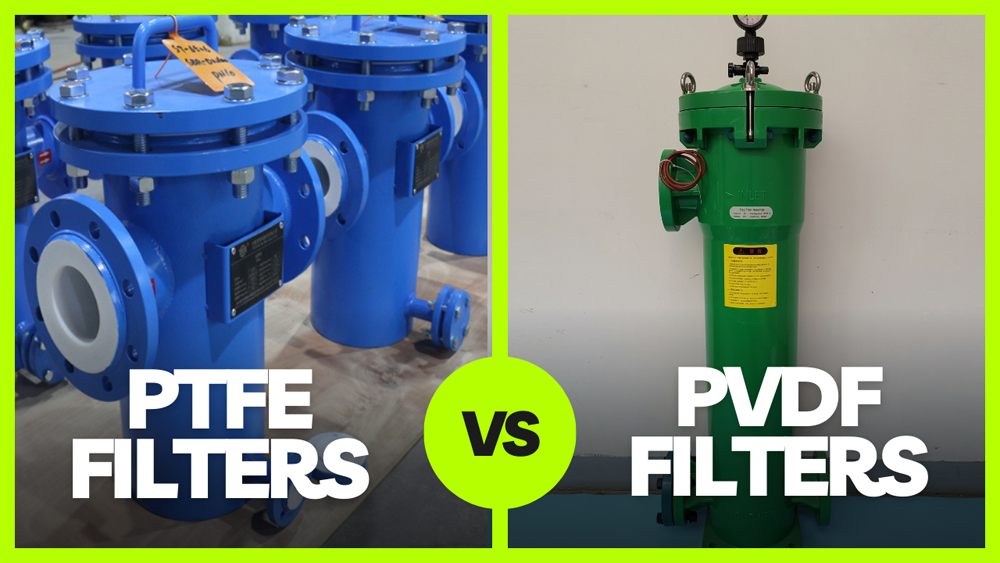
In the realm of industrial filtration, the materials used in the construction of filters play a pivotal role in determining the effectiveness and longevity of the filtration process. Two of the most commonly employed materials are Poly tetrafluoroethylene (PTFE) and Polyvinylidene fluoride (PVDF), each possessing attributes that suit various industrial needs.
Poly tetrafluoroethylene, commonly known as PTFE, is renowned for its exceptional chemical inertness and ability to withstand temperatures up to 260°C. It is hydrophobic, meaning it repels water, making it ideal for applications involving aggressive organic solvents, acids, and bases. Its non-stick surface is particularly advantageous in preventing build-up and facilitating easy cleaning.
Polyvinylidene fluoride, or PVDF, stands out for its robust mechanical strength and good resistance to abrasion. It can operate in temperatures up to 150°C and offers excellent resistance to UV radiation and fungal growth. PVDF is slightly less chemically resistant than PTFE but is preferred in applications where higher physical strength is required.
Table 1: Comparison of Physical Properties
| Property | PTFE | PVDF |
| Temperature Max | 260°C | 150°C |
| Chemical Resistance | Excellent | Good |
| UV Resistance | Low | High |
| Mechanical Strength | Moderate | High |
The choice between PTFE and PVDF often comes down to the specific needs of the application. For environments involving high temperatures and aggressive chemicals, PTFE is typically the better choice. Conversely, for applications requiring high mechanical strength and resistance to UV exposure, PVDF may be more suitable.
Understanding the distinct physical and chemical properties of PTFE and PVDF is crucial in choosing the right filter material for specific applications. Each material offers unique characteristics that make them suitable for different environments and challenges.
PTFE, with its high melting point, excels in environments that require thermal stability. It remains stable and functional at temperatures that would degrade many other materials. On the other hand, PVDF, while not as heat resistant as PTFE, offers superior wear resistance and mechanical strength, making it ideal for more physically demanding applications.
Chemically, PTFE is almost completely inert, making it resistant to virtually all chemicals, which is why it is often used in handling corrosive substances. PVDF doesn't quite match PTFE's level of chemical resistance but still performs well against most acids and solvents, and it offers better resistance against chlorine and bromine environments.
The choice between PTFE and PVDF filters often depends on their specific applications within various industries. Each material's unique properties tailor them for certain environments and tasks, influencing their selection for particular roles.
Chemical Processing: Due to its inertness, PTFE is commonly used in the chemical industry, particularly in handling highly corrosive substances that would degrade other materials.
Pharmaceuticals: PTFE's ability to operate at high temperatures and resist contamination makes it ideal for sterile processes.
Food and Beverage: The non-stick nature of PTFE is beneficial in food processing, where cleanliness and avoiding contamination are crucial.
Water Treatment: PVDF's resistance to chlorine and microbial growth makes it suitable for filtration systems in water treatment facilities.
Semiconductor Manufacturing: The high purity and good mechanical strength of PVDF filters are vital in the semiconductor industry, where even minute contaminants can ruin batches.
Oil and Gas: PVDF's robustness makes it a preferred choice for oil and gas applications, where filters must withstand harsh conditions and aggressive chemicals.
Table 2: Industrial Applications of PTFE and PVDF Filters
| Industry | PTFE Applications | PVDF Applications |
| Chemical Processing | Handling corrosive substances | Less suitable |
| Pharmaceuticals | High-temperature processes | Less suitable |
| Food and Beverage | Non-stick applications | Less suitable |
| Water Treatment | Less suitable | Filtration systems |
| Semiconductor | Less suitable | High purity needs |
| Oil and Gas | Less suitable | Harsh environmental conditions |
When selecting a filter material, weighing the advantages and disadvantages of PTFE and PVDF can guide decision-making, ensuring the choice aligns with specific industrial needs and environments.
1.Chemical Resistance: PTFE exhibits superior chemical inertness, making it ideal for harsh chemical environments where other materials fail.
2.Temperature Resistance: It can withstand temperatures up to 260°C, suitable for high-temperature applications.
3.Non-Stick Surface: This feature makes it easy to clean and maintain, reducing downtime in processes.
1.Cost: PTFE is generally more expensive than PVDF, which can be a limiting factor for budget-conscious operations.
2.Mechanical Strength: Less robust than PVDF, making it less ideal for applications requiring high mechanical stress.
1.Mechanical Strength: Offers better mechanical strength and durability compared to PTFE, suitable for physically demanding environments.
2.UV Resistance: Exhibits excellent resistance to UV, making it ideal for outdoor applications.
3.Cost-Effectiveness: Generally less expensive than PTFE while still offering good chemical and temperature resistance.
1.Chemical Resistance: While still high, it does not match the chemical resistance of PTFE, making it less suitable for extremely corrosive environments.
2.Temperature Limitations: With a maximum operating temperature of 150°C, it is less versatile in high-temperature scenarios compared to PTFE.
In the world of industrial filtration, the choice between PTFE and PVDF filters can significantly impact the efficiency and effectiveness of your processes. PTFE, with its superior chemical and temperature resistance, is ideal for applications involving harsh chemicals and high temperatures. Conversely, PVDF, offering excellent mechanical strength and cost-effectiveness, is suited for environments where physical durability and budget are key considerations.
The decision between these two materials should be guided by the specific requirements of your application, including the chemical nature of the substances being filtered, the environmental conditions, and the economic factors involved. By carefully considering the properties, advantages, and disadvantages of each material, as presented in this article, industry professionals can make informed choices that optimize their filtration systems for both performance and longevity.
Feel free to leave your message on our board. If you're looking to inquire about prices or place an order, this is the right place! Let us know the details of your needs, and our team will get back to you with a personalized quote as quickly as possible. We're here to ensure your experience is seamless and satisfactory. Share your requirements or ask any questions you might have - we're eager to assist and look forward to doing business with you!
Name:Tim
Phone:+86-15716151880
Email:[email protected]
Company:BEANT
Address:No. 28, Luoshen Road, Luoshe Town, Huishan District, Wuxi City, Jiangsu Province
